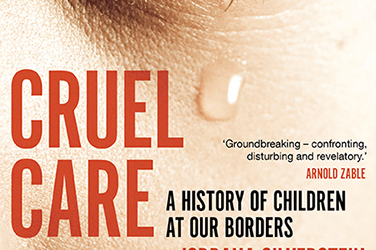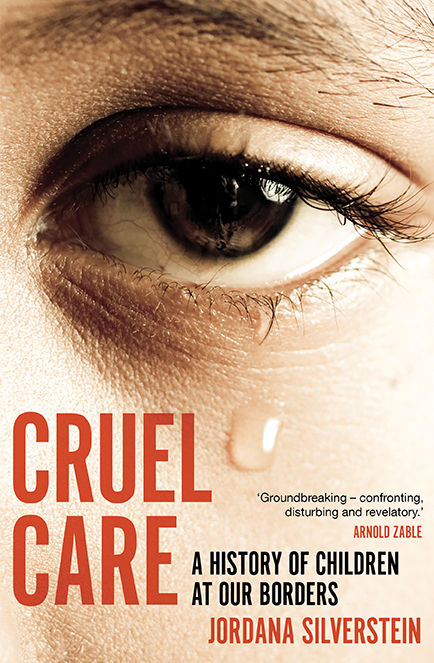
- Free Article: No
- Contents Category: History
- Review Article: Yes
- Article Title: How could we do this?
- Article Subtitle: A national reckoning on child refugees
- Online Only: No
- Custom Highlight Text:
The historian Jordana Silverstein’s masterful new book, Cruel Care, begins with an account of the Murugappan family. Many Australians will remember this family: the hard-working parents seeking asylum from Sri Lanka, and their two Australian-born children, taken from their home in Biloela by the Australian government at five o’clock one morning in 2018. The family was detained for four years in Melbourne and Perth and on Christmas Island. The case was so drawn out that, in the rare photographs released to the public, we saw the children growing up. Their treatment was illogical, unjust, unkind, and expensive, and provoked a sharp emotional response from the public.
- Featured Image (400px * 250px):

- Alt Tag (Featured Image): Amy Nethery reviews 'Cruel Care: A history of children at our borders' by Jordana Silverstein
- Book 1 Title: Cruel Care
- Book 1 Subtitle: A history of children at our borders
- Book 1 Biblio: Monash University Publishing, $34.99 pb, 309 pp
- Book 1 Cover Small (400 x 600):

- Book 1 Cover (800 x 1200):

First, Silverstein pinpoints the emotional hypocrisy that politicians engage in when they justify Australia’s asylum policies as being in ‘the best interests of the child’. This phrase, present in law and in political discourse, has dominated debate on asylum seekers for a decade. During 2009–13, Australia experienced the largest number of people seeking asylum by boat, primarily fleeing the violence of the Taliban in Afghanistan. Australia’s diplomacy in Indonesia had led to stricter laws and a more ruthless people-smuggling operation; people seeking asylum no longer waited until the safer dry season to journey to Australia. Boats sank, and an estimated nine hundred people, including children, drowned.
Successive governments (Labor and Coalition) feared being punished at the ballot box if they were accused of losing control over Australia’s borders. So they told the Australian public that their egregiously punitive, damaging, and expensive asylum policies were needed, not only to maintain the integrity of borders, but also to save refugee children from drowning at sea.
In order to stop refugee children from reaching Australia by boat, our governments punished those who had survived the journey. Boat turn-backs, indefinite detention, and the removal of all possibility of settling in Australia were the methods by which policymakers could ‘break the people smugglers’ business model’. As Silverstein points out, no child benefits from the policies constructed upon this logic: they drown because there is no safe pathway to protection; those who survive the journey are damaged in mandatory, indefinite, and unsafe detention; and those who remain are trapped indefinitely in countries that do not recognise their refugee status. The only winners are the politicians who profit electorally by repeating the mantra that they have saved children from drowning.
This is a well-trodden analysis, but the interviews and archival research in Cruel Care bring many new insights. Silverstein has interviewed several former immigration ministers, government and opposition politicians and strategists, and key policymakers, and having their views on the record is valuable. A theme repeated by all her interviewees is the difficulty of the asylum policy portfolio. Yet, as Silverstein shows, after all the deliberations are done, policymakers unfailingly come down on the side of ‘protecting the borders’, ‘national integrity’, or ‘stopping children drowning at sea’. All three phrases result in the same policy response. In these deliberations, no attention is paid to the reasons people are forced to flee their homes, or how Australia might provide a safer pathway to protection, or respond more humanely to those who arrive.
This feigned concern about children is the narrative we tell ourselves that allows us to carry on, cultivating a false identity that, beneath it all, we, as Australians, are kind and humane. In response, Silverstein offers her second answer to the crucial question of how we could do this to children. Her blunt appraisal is this: in settler colonial Australia this is how we have always treated children. Not all children, of course, but non-white children whose presence threatens the national identity of the settler colonial state. Violent, racist, and paternalistic policies are enacted against children, and their parents, by the white settlers who know what’s best. At the same time as we devise creative and notorious ways for punishing refugee children, we have the world’s highest rates of incarceration of First Nations children and the highest rates of removing First Nations children from their families. ‘The problem,’ Silverstein states, ‘is the colony and how it governs.’
Silverstein confesses that this second, more fundamental answer forced its way into her book, a second answer overlaying the first. The result is a book in which two complex ideas compete for attention – in some chapters more successfully than others. Where it is most compelling is in the penultimate chapter, in which Silverstein analyses the careers of three public servants instrumental in designing asylum policy. One in particular, Wayne Gibbons, could rightfully claim to be the architect of both the Pacific Solution and the Northern Territory Intervention. Suddenly, the continuities between asylum and First Nations policy are no longer theoretical.
Silverstein’s argument that asylum policy flows directly from the racialised logic inherent in settler colonialism is one Australians need to address. But it offers little hope for those whose energies are directed towards achieving more humane asylum policies. Is Australia forever destined to respond cruelly to people seeking asylum? Silverstein doesn’t engage with questions relating to the future of asylum policy; she explains that ‘it is not my place as a coloniser on Indigenous land to say precisely what should happen with that land’. Yet we don’t have to look far to find other settler colonies that have been much more generous to refugees. As we tentatively begin the process of Voice, treaty, and truth-telling, perhaps asylum seekers will be unexpected beneficiaries of our national reckoning.


Comments powered by CComment